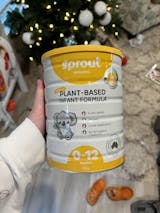
Hypoallergenic (HA) Formula – Hydrolyzed milk protein for easier digestion
Share
Hydrolyzed formula which is marketed as "HA" (Hypoallergenic) is a type of infant formula that has undergone a process called hydrolysis. Hydrolysis involves breaking down proteins into smaller fragments, making them easier to digest. This process is typically done to reduce the risk of allergic reactions in infants who may have a sensitivity or intolerance to intact proteins.
Hydrolyzed formulas are formulated to mimic the composition of breast milk while reducing the allergenic potential of intact proteins.
Common symptoms indicating the need for HA formula
If you are considering whether HA (Hypoallergenic) formula is required for your baby, it's important to consult with a healthcare professional, however, here are some common symptoms that may indicate the need for HA formula:
- Allergic Reactions: If your baby experiences allergic reactions after consuming regular infant formula or breast milk, such as hives, rash, swelling, wheezing, or difficulty breathing, it could suggest a potential allergy to cow's milk protein.
- Digestive Issues: Babies with cow's milk protein allergy or sensitivity may experience digestive symptoms, including frequent spitting up, vomiting, diarrhea, constipation, excessive gas, bloating, or abdominal pain.
- Skin Conditions: Skin issues like eczema, characterized by dry, itchy, and inflamed skin, can sometimes be associated with cow's milk protein allergy. If your baby has persistent or severe eczema, it may be worth considering the possibility of an underlying allergy.
- Respiratory Symptoms: Some babies with cow's milk protein allergy may experience respiratory symptoms such as coughing, wheezing, or congestion after consuming cow's milk-based products.
- Failure to Thrive: If your baby is not gaining weight appropriately, has poor growth, or exhibits signs of malnutrition despite adequate feeding, it could indicate an underlying issue such as cow's milk protein allergy.
These symptoms alone may not conclusively indicate the need for HA formula, proper evaluation and diagnosis by a healthcare professional is crucial for accurate assessment and appropriate management.
HiPP HA (Hypoallergenic) formula benefits
Here are some ways HiPP HA formula can benefit babies:
- Reduced Allergenic Potential: The proteins in HiPP HA formula undergo extensive hydrolysis, which means they are broken down into smaller fragments. This process reduces the allergenic potential of the proteins, making them less likely to trigger an allergic reaction in babies with cow's milk protein allergy or sensitivity.
- Easier Digestion: The smaller protein fragments in HiPP HA formula are easier for babies to digest compared to intact proteins. This can help alleviate digestive discomfort, such as colic, gas, or fussiness, that may be associated with difficulties in digesting intact proteins.
- Allergy Prevention: HiPP HA formula is often recommended for infants who have a high risk of developing allergies due to a family history of allergies. By introducing an extensively hydrolyzed formula, it is believed to help reduce the likelihood of developing allergic reactions to cow's milk protein.
- Nutritional Support: HiPP HA formula is nutritionally balanced and formulated to provide the necessary nutrients for healthy growth and development in infants. It contains carbohydrates, fats, proteins, vitamins, and minerals that support their nutritional needs.
- Breast Milk Substitute: In cases where breastfeeding is not possible or insufficient, HiPP HA formula can serve as an alternative to breast milk. It provides a nutritionally complete option that is suitable for babies with cow's milk protein allergy or sensitivity.
Conclusion
Cow's milk protein allergy (CMPA) is one of the primary health issues that may require the use of HA formula. CMPA is estimated to affect around 2-3% of infants worldwide, although the prevalence can vary in different populations.
The decision to use HA formula is typically made based on individual circumstances and guidance from healthcare professionals such as pediatricians or allergists.

Rodney Hyde
International Formula Expert – Grow Organic Baby

